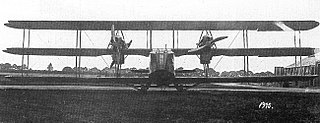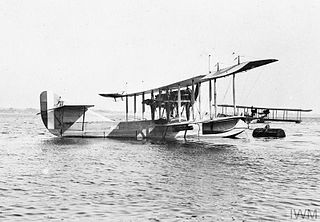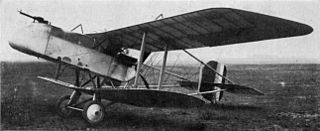
The Naval Aircraft Factory (NAF) was established by the United States Navy in 1918 in Philadelphia, Pennsylvania. It was created to help solve aircraft supply issues which faced the Navy Department upon the entry of the U.S. into World War I. The US Army’s requirements for an enormous quantity of airplanes created a decided lack of interest among aircraft manufacturers in the Navy's requirements for a comparatively small quantity of aircraft. The Navy Department concluded that it was necessary to build a Navy-owned aircraft factory in order to assure a part of its aircraft supply; to obtain cost data for the department’s guidance in its dealings with private manufacturers; and to have under its own control a factory capable of producing experimental designs.

The Douglas DT bomber was the Douglas Aircraft Company's first military contract, forging a link between the company and the United States Navy. Navy Contract No. 53305 of April 1, 1921, required only 18 pages to set out the specifications that resulted in the purchase of three DT folding-wing aircraft.

The Boeing XPBB-1 Sea Ranger was a prototype twin-engined flying boat patrol bomber built for the United States Navy. The order for this aircraft was canceled, to free production capacity to build the Boeing B-29, and only a single prototype was completed.

The Naval Aircraft Factory TS-1 was an early biplane fighter aircraft of the United States Navy, serving from 1922 to 1929.

The twin-engine F5L was one of the Felixstowe F series of flying boats developed by John Cyril Porte at the Seaplane Experimental Station, Felixstowe, England, during the First World War for production in America.

The Bristol Braemar was a British heavy bomber aircraft developed at the end of the First World War for the Royal Air Force. Only two prototypes were constructed.

PZL.12 (PZL-H) was a prototype of a Polish amphibious flying boat designed and built in 1931 by Zygmunt Puławski, a pioneering Polish designer. He was killed in a crash involving this design.

The Curtiss Model H was a family of classes of early long-range flying boats, the first two of which were developed directly on commission in the United States in response to the £10,000 prize challenge issued in 1913 by the London newspaper, the Daily Mail, for the first non-stop aerial crossing of the Atlantic. As the first aircraft having transatlantic range and cargo-carrying capacity, it became the grandfather development leading to early international commercial air travel, and by extension, to the modern world of commercial aviation. The last widely produced class, the Model H-12, was retrospectively designated Model 6 by Curtiss' company in the 1930s, and various classes have variants with suffixed letters indicating differences.
The Naval Aircraft Factory TF was an American twin-engine flying-boat escort fighter first flown in October 1920. The aircraft originated from requirements drafted by the British Technical Committee in April 1918, after discussion approved the development of a long-range seaborne fighter capable of escorting Allied maritime reconnaissance sorties over the North Sea and Atlantic regions.

The Curtiss HS was a single-engined patrol flying boat built for the United States Navy during World War I. Large numbers were built from 1917 to 1919, with the type being used to carry out anti-submarine patrols from bases in France from June 1918. It remained in use with the US Navy until 1928, and was also widely used as a civil passenger and utility aircraft.

The Curtiss Model R was a utility aircraft produced for the United States Army and Navy during World War I. It was a conventional, two-bay biplane with slightly staggered wings of unequal span. The aircraft was provided with two open cockpits in tandem and fixed tailskid undercarriage, but many were built for the Navy with twin floats replacing the wheels. During the course of the war, Model Rs were used for general liaison and communication duties, as well for observation, training, and as air ambulances. In practice, the Curtiss powerplants supplied with these aircraft proved insufficient and were mostly replaced with Liberty engines. The Navy's Model R-3 floatplane had extended-span, three-bay wings, and was intended for use as a torpedo bomber. Some of these were later fitted with wheeled undercarriage and transferred to the Army as bombers under the designation Model R-9.
The Aichi AB-4 was a Japanese flying boat of the 1930s. A single engined biplane, the AB-4 was intended to carry out night reconnaissance for the Imperial Japanese Navy. Six were built and accepted into service as the Experimental 6-Shi Night Reconnaissance Flying boat, three of which were converted to civil transports.

The Royal Aircraft Factory F.E.9 was a prototype British two-seat fighter-reconnaissance aircraft of the First World War. A single-engined pusher biplane of 1917, the F.E.9 had poor performance and handling, and only three were built.

The Royal Aircraft Factory N.E.1 was a prototype British Night fighter of the First World War. A single-engined pusher biplane, it was a development of the Royal Aircraft Factory's earlier F.E.9 fighter, but was not successful, only six being built.

The Yokosuka Ro-go Ko-gata was a Japanese reconnaissance floatplane developed during the First World War by the Japanese Navy Arsenal at Yokosuka, and one of the first indigenous Japanese aircraft to enter production. There were 218 of these aircraft built for the Imperial Japanese Navy, which remained in use until 1928.
The Royal Aircraft Factory F.E.3 (also known as the A.E.1 was a British experimental single-engined pusher biplane built prior to the First World War. It was intended to be fitted with a shell-firing gun, but was quickly abandoned, being found to be structurally unsound.
The Royal Aircraft Factory C.E.1 was a prototype British flying boat of the First World War. It was a single-engined pusher configuration biplane intended to carry out coastal patrols to protect shipping against German U-boats, but only two were built, the only flying boats to be designed and built by the Royal Aircraft Factory.

The Vickers F.B.25 was a British two-seat night fighter prototype of World War I designed to attack enemy airships. Completed in 1917, it failed in its official flight tests that year and no order for production resulted.
The Mitsubishi Ka-8 or Mitsubishi Experimental 8-Shi Two-seat Fighter was a prototype Japanese two-seat carrier-based fighter of the 1930s. Two were built, but no production followed.
The Naval Aircraft Factory Giant Boat or GB was a 1919 maritime patrol aircraft project undertaken by the Naval Aircraft Factory (NAF), the in-house aircraft production arm of the United States Navy. The proposed flying boat was larger and heavier and would have possessed a longer range than any similar type then in existence, but the project was hampered by labor and funding shortages stemming from deep post-World War I U.S. military budget cuts, and in 1921, navy leaders prioritized other aircraft types and ended the project. The single incomplete prototype is believed to have been broken up after 1925.














